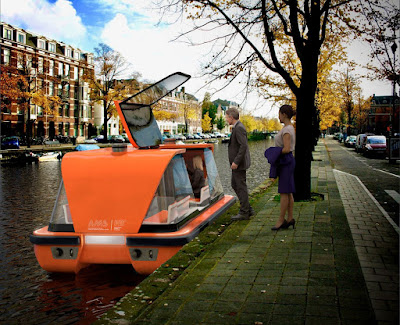MIT's e, Autonomous Water Taxis
MIT Zero Emissions Water Taxis to Be Deployed in Amsterdam
Innovative Water Shuttles for Amsterdam Canals
From the world famous MIT C-SAIL a team of engineers and roboticists have created the Roboat, a robotic boat that uses the same autonomous, electric self-driving technology for cars but adapted for the water. Their adaptation is extremely innovative and it is soon to be launched as a water taxi service for Amsterdam commuters, pending governmental approvals. Small autonomous electric boat shuttles, spun off from a larger scale version of this innovative technology, are about to cruise on Amsterdam's famous canals to transport people and goods. This will be the world's first fleet of autonomous water vessels to service a city. It is a collaboration between MIT and the Amsterdam Institute for Advanced Metropolitan Solutions that is paving the way for new travel solutions - water transit solutions in congested cities.
MIT Innovation
This robotic water technology has been under development for more than five years by MIT. It is now large enough to carry passengers through the tricky canals in Amsterdam. The technology will launch with a small, 1.1 scale prototype of what has been under development on a larger scale. The water taxis consist of a hull, 4 thrusters that move in any direction and numerous safety sensors including LIDAR, GPS and cameras to avoid objects, pinpoint positioning and stay on course. It does so autonomously. The boats are 13 feet long, travel at 4 mph. and can run for 12 to 24 hours a day depending upon the electric battery type and cargo. They are steered remotely by computer. The computer processes data from the cameras and sensors on the boat to navigate safely around moving and stationary objects. And the vessel is modular so it can be customized for people or goods.
Future
Beyond the new commuter water shuttles, MIT roboticists have demonstrated that the Roboats are capable on a much larger scale of communicating and connecting with each other for such uses as bridges across the canals and staging areas. They've been able to provide these multifaceted solutions because of greatly advanced control algorithms and navigation systems. That capability opens up new forms of transportation possibilities on the water. MIT has been working on this technology for many years.
Impressive Technology
There are a number of things impressive about this new, robotic technology. It is intelligent enough to self-navigate the complex waterways of Amsterdam. Also the roboats are modular and can self-assemble into a large fleet unit, led by a leader roboat. That allows for many more uses including carrying commuters, doing deliveries and collecting waste. This is a very significant new form of urban transportation that MIT engineers continue to work on. They continue to advance the self-steering technology and expect to do so for another two to four years.

%20(1)%20(1)%20(3)%20(2)%20(2).jpg)


Comments
Post a Comment